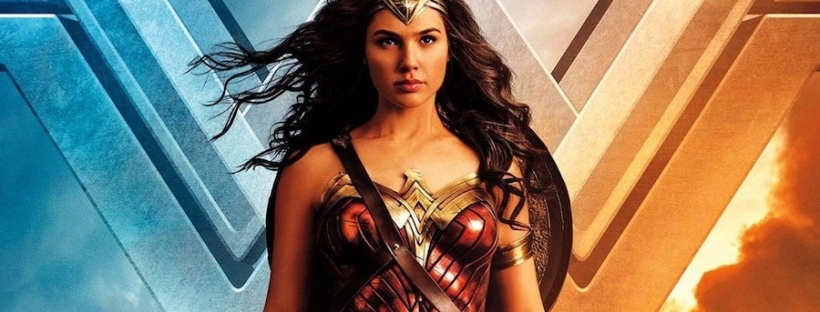Written by Savannah Jackson; ed. assistance Nancer Ballard.
Leading up to, and since its release, the DC superhero(ine) movie Wonder Woman (2017) has garnered approval for partaking in the new wave of “feminist” movies due to its female director (Patty Jenkins) and protagonist. The movie follows Diana Prince (Gal Gadot) who, having grown up in a mythic land surrounded only by powerful women, struggles to achieve success in a man’s “real” world (both on and off the battlefield) and make sense of her identity. Placing a confident woman hero on the big screen is a success for female representation in the film industry, but the movie does little to alter the typical male heroic plot. Some have argued that Diana’s completion of the Hero’s Journey is long-needed proof that the monomyth applies to both men and women, but this ignores countless women who’ve already gone through the Hero’s Journey, and men who’ve completed the Heroine’s Journey. We believe that, while this movie shows young girls and women that they can take the main stage, it fails to present them with any alternative to the masculine narrative society usually demands they fit themselves into if they want to succeed.
In the recent movie, Diana’s story begins on the secluded, paradisiacal island of Themyscira, and it is all Diana has ever known. This is her ordinary world where she feels safe and comfortable, and yet, there is tension between her and her mother, Hippolyta (Connie Nielsen), who forbids her from learning to fight, knowing that Diana’s growing strength makes it easier for Ares (David Thewlis), the god of war, to discover and destroy her. Diana looks up to her aunt Antiope (Robin Wright), who goes behind Hippolyta’s back to teach Diana to fight and is a strong role model (mentor) for the young superheroine-to-be. Diana refuses her personal call to leave the island out of respect for her mother’s wishes—to a certain point. However, the death of her mentor and her second call to adventure coincide when World War II pilot Steve Trevor (Chris Pine) crashes from the sky and convinces Diana that the world beyond her island cannot be ignored.
While many Hero Journey characters metaphorically cross the threshold, Diana literally crosses the veil that separates and protects Themyscira from the time-bound outside world currently engaged in WWII. Diana encounters her tests, allies, and enemies as she befriends those fighting with Steve (Samir, Charlie, and Chief) in the war, struggles to comprehend the suffering around her, and combats the villainous Nazi doctors (Ludendorff and Dr. Maru). As the team goes through their approach and prepares to confront and defeat the doctors creating weapons of pain and destruction, Diana reaches her ordeal when she decides to cross through No Man’s Land.

Through this scene, Diana recognizes her potential and secures her position as a leader. There is reward in the trust she has gained and the brief moment of peace experienced by the small town she liberates. For a moment Diana imagines a less chaotic life with Steve, but she’s not deterred from continuing with their plan to kill the Nazi doctors and thus end the production of their weapons. The group finally confronts Ludendorff but is unable to prevent the death of the people of the small town Diana liberated only moments ago. Diana eventually kills Ludendorff, but this does nothing to end the war, and she grapples with the reality of this. Diana loses faith in the possible goodness of man but when Steve tells Diana she is the best equipped to save mankind, she accepts all her superhuman powers and fights Ares (e.g. Resurrection). Having accepted and fully achieved her role as a superhuman weapon, Diana turns Ares’ power against him and defeats him, thus reaching the climax of the movie. Having been recognized as a leader and savior by Steve—the ones who counts in Diana’s mind—the movie jumps to Diana in the modern day where she continues her commitment to fight for justice, keeping the picture of her times with Steve close at hand.
Wonder Woman’s message that a Hero’s Journey can be completed by both women and men is not revolutionary, although it is a positive development that Diana, as a female hero, isn’t immediately killed upon completing the journey’s arc. At its core, the movie reinforces the masculine Hero’s Journey paradigm rather than moving toward a larger vision of wholeness. Throughout her journey, Diana seems to only come closer to the preordained role she already desired. She questions the efficacy of violence when she succeeds in killing Ludendorff and nothing changes, but instead of altering her worldview and coming to terms with this, she doubles down and confronts Ares to destroy him and end the war.
There is ironic beauty in Diana defeating Ares by harnessing his own power and turning it against him, but this is not necessarily a new, un-masculine tactic. Diana kills the god of war, and in the flash forward to the future, she seems to still be content with this. She accepts her duty to protect mankind even if they do not deserve it but falls short of healing a mother/daughter split. Diana does not have to reconcile her view with her mother’s admonition that “fighting does not make you a hero.” In the present “real” world, Diana Prince—Wonder Woman—still fights in the name of justice, and ultimately is stuck within the constraints of the Hero’s Journey.

5 thoughts on “Wonder Woman: Another Hero’s Journey Hollywood Success”